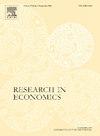自然资源丰富与收入不平等:来自印度的时间序列证据
IF 1.2
Q3 ECONOMICS
引用次数: 0
摘要
本研究考察了1971年至2020年期间印度自然资源的丰富程度如何影响收入不平等。本研究采用Lee and Strazicich单位根检验来识别数据中的结构断裂,采用bayer - hank协整检验,采用FMOLS、DOLS、CRR等方法估计长期系数。此外,为了确定变量之间的因果关系方向,使用了成对格兰杰因果关系检验。协整的bayer - hank检验结果证实变量之间存在长期关联。实证结果表明,收入不平等与自然资源、城市化、数字化和物质资本呈显著正相关,与人力资本呈负相关。格兰杰因果检验表明,自然资源与数字化之间存在双向因果关系,而人力资本和物质资本与收入不平等之间存在单向因果关系。这项研究的结果建议政策制定者,解决印度的收入不平等问题需要有效和公平的资源分配,确保其公民的数字包容,经济一体化,促进可持续的城市发展以及人力和物质资本投资。本文章由计算机程序翻译,如有差异,请以英文原文为准。
Natural resources abundance and Income Inequality: Time series evidence from India
This study examines how the abundance of natural resources influences income inequality in India for the period 1971 to 2020. The study employs the Lee and Strazicich unit root test to identify structural break in the data, the Bayer-Hanck test of Co-integration and, methods for example FMOLS, DOLS and CRR to estimate long run coefficient. Further, to determine the direction of causality among the variables, Pairwise Granger Causality Tests is used. The results of Bayer-Hanck test for Co-integration confirms the presence of long-run association among variables. Empirical results show that income inequality is positively and significantly related with natural resources, urbanization, digitalization and physical capital, while it is negatively associated with human capital. The Granger Causality test reveals a bidirectional causal relation between natural resources and digitalization, whereas a unidirectional causal relationship is observed from human capital and physical capital to income inequality. The result of this study recommends policymakers, addressing income inequality in India requires effective and equitable allocation of resources, ensuring digital inclusion of its citizens, economic integration, promoting sustainable urban development and investment in both human and physical capital.
求助全文
通过发布文献求助,成功后即可免费获取论文全文。
去求助
来源期刊

Research in Economics
ECONOMICS-
CiteScore
1.40
自引率
0.00%
发文量
37
审稿时长
89 days
期刊介绍:
Established in 1947, Research in Economics is one of the oldest general-interest economics journals in the world and the main one among those based in Italy. The purpose of the journal is to select original theoretical and empirical articles that will have high impact on the debate in the social sciences; since 1947, it has published important research contributions on a wide range of topics. A summary of our editorial policy is this: the editors make a preliminary assessment of whether the results of a paper, if correct, are worth publishing. If so one of the associate editors reviews the paper: from the reviewer we expect to learn if the paper is understandable and coherent and - within reasonable bounds - the results are correct. We believe that long lags in publication and multiple demands for revision simply slow scientific progress. Our goal is to provide you a definitive answer within one month of submission. We give the editors one week to judge the overall contribution and if acceptable send your paper to an associate editor. We expect the associate editor to provide a more detailed evaluation within three weeks so that the editors can make a final decision before the month expires. In the (rare) case of a revision we allow four months and in the case of conditional acceptance we allow two months to submit the final version. In both cases we expect a cover letter explaining how you met the requirements. For conditional acceptance the editors will verify that the requirements were met. In the case of revision the original associate editor will do so. If the revision cannot be at least conditionally accepted it is rejected: there is no second revision.
 求助内容:
求助内容: 应助结果提醒方式:
应助结果提醒方式:


